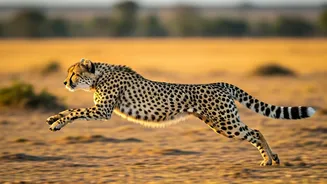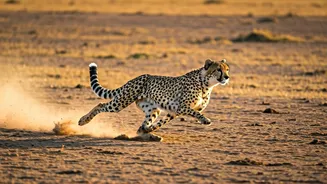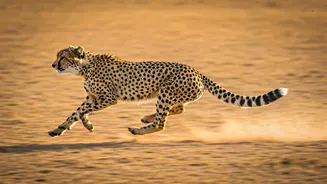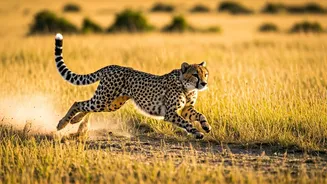The Cheetah's Burst
The cheetah, a symbol of speed, claims the title of the world's fastest land animal. Found in Africa, these big cats can accelerate from 0 to 60 mph in mere
seconds, faster than many sports cars. Their streamlined bodies, flexible spines, and specialized claws contribute to their incredible agility. The cheetah's speed is crucial for survival, allowing it to hunt prey in open grasslands, providing them the energy they require for their life. These creatures can reach speeds exceeding 70 mph (112 kph) in short bursts, making them formidable hunters.
Peregrine Falcon’s Dive
The peregrine falcon stands out as the world's fastest animal overall, particularly during its hunting dives. These birds of prey can reach speeds of over 200 mph (320 kph) as they swoop down on unsuspecting prey from high altitudes. Their streamlined body shape and powerful wings allow them to cut through the air with unmatched efficiency. Found across the globe, peregrine falcons are a testament to the power of natural selection and the adaptations that allow animals to thrive in diverse environments. Their speed is a primary aspect for their survival.
Sailfish's Underwater Dash
Sailfish hold the record for the fastest swimmers in the ocean. These magnificent creatures can reach speeds of up to 70 mph (112 kph) in pursuit of their prey. The sailfish's name comes from its large dorsal fin, which it can raise like a sail, and also helps in maneuvering. Their streamlined bodies and powerful tails enable them to navigate through the water with incredible agility. Sailfish are found in warm waters worldwide, where they use their speed to catch smaller fish.
Pronghorn’s Endurance
The pronghorn, native to North America, is the second-fastest land mammal. Unlike the cheetah, the pronghorn excels at sustained high-speed running. They can maintain speeds of up to 55 mph (88 kph) for extended periods, making them difficult to catch for predators. Pronghorn have large lungs and hearts, enabling efficient oxygen intake and endurance. Their speed serves them well, allowing them to escape predators and forage across expansive plains. The pronghorn's speed is a crucial adaptation.
The Frigatebird's Flight
Frigatebirds, also known as man-o'-war birds, are aerial masters, with exceptional flight capabilities and impressive speed in the air. Their long wings and lightweight bodies enable them to stay aloft for days, soaring to hunt prey. They can reach speeds of up to 95 mph (153 kph), particularly during dives to snatch fish from the ocean's surface. Frigatebirds are found in tropical and subtropical regions, demonstrating their incredible adaptation for flight.
The Black Marlin's Rush
Black marlin, another remarkable marine creature, is celebrated for its incredible speed and size. They can swim at speeds of up to 80 mph (129 kph) in short bursts, making them one of the fastest fish. Found in tropical and subtropical waters, black marlin are powerful predators, using their speed to catch a variety of marine life. Their large size and impressive speed enable them to dominate their oceanic environment. The black marlin's speed is essential for both hunting and survival.
The Lion's Pursuit
Lions, the apex predators of the African savanna, are renowned for their strength and speed. They can reach speeds of up to 50 mph (80 kph) during short chases, allowing them to ambush and capture their prey. Lions' speed is especially impressive considering their considerable size and weight. The lion's coordinated teamwork and strategic hunting methods often lead to successful hunts, solidifying their dominance in the ecosystem. The lion's speed is a key element of its hunting success.





